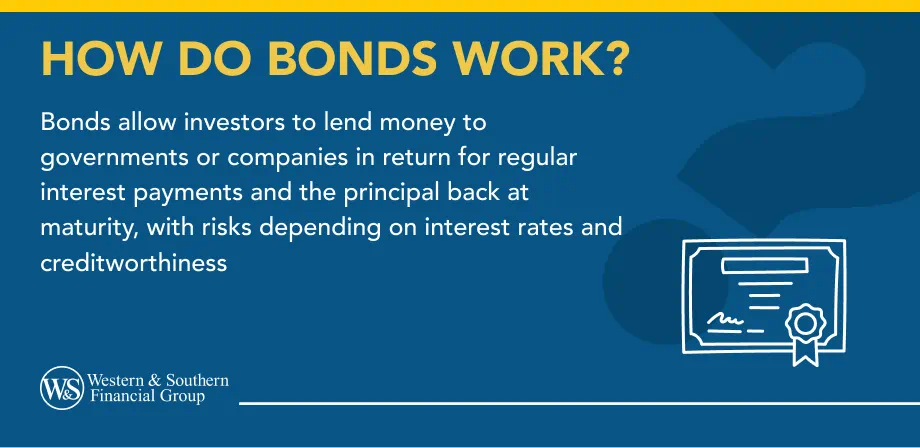Table of Contents
Table of Contents


Key Takeaways
- When you buy a bond you are lending money to the issuer for a set period of time in exchange for regular interest payments and repayment of principal at maturity.
- Interest rates affect bond prices - rates rise, bond prices tend to fall. Rates fall, bond prices tend to rise.
- Bond ratings from agencies help assess credit risk and interest rate - higher rated bonds are safer with lower rates.
- Many types of bonds exist like government, corporate, municipal, junk bonds etc. with different risks.
- Bonds tend to be less volatile than stocks but have more limited upside. Risks include interest rate fluctuations and potential default.
Bonds can be standard components of many diversified portfolios. While they're popular with conservative investors, they may also be useful for more aggressive ones.
Among other things, bonds can potentially dampen the effects of stock market volatility on a portfolio while providing income. But as with any investment, they can also lose money.
What Is a Bond?
When you buy a bond, you lend money to the bond issuer, which could be a business, a government body or another organization, for a specified period of time. In return, the issuer promises to repay the loan at the end of the bond's term either in regular installments during the term or in full at the end.
A bond can be bought or sold in global financial markets, but a bond's market value can change depending on demand and economic conditions.
Individual Bonds
Bonds can be bought individually. With individual bonds, you can select specific issuers and interest rates, or buy bonds with scheduled repayment dates that align with your needs. You can keep the bond until it matures, or you can sell it to other investors in the secondary market. If you hold until maturity and the issuer successfully repays, you should receive the full amount promised, even if the bond's market price fluctuates over time.
Multiple Bonds
Bond mutual funds purchase multiple bonds for you. A mutual fund might own hundreds or thousands of bonds from a variety of issuers and with different maturity dates. Mutual fund prices fluctuate daily as the underlying holdings gain or lose value. There's no guarantee you'll receive a particular rate of return from a mutual fund.
How Do Bonds Work?
Bonds pay interest on the amount you lend to issuers. These interest rates are set by the issuer, who factors in economic conditions and the credit rating of the issuer.
Interest Rates
Interest rates in the broader economy affect everything from savings account rates to mortgages. If those rates rise (as the demand for money increases), interest rates on newly issued bonds often rise with them, though bond prices on a whole tend to decrease. Standard bonds keep the same interest rates after being issued, so the prevailing interest rates may move higher or lower than the interest rate on a given bond.
Bond Ratings
Bond ratings agencies can help investors evaluate risk: A strong issuer might receive a "AAA" rating, while a higher-risk issuer may earn a "C" rating.
In general, the higher the rating, the lower the interest rate.
- Issuers with poor ratings need to pay higher rates to compensate investors for taking more risk.
- Financially strong issuers can borrow at the lowest interest rates, because investors are confident those issuers will follow through on payments.
Although bond ratings are helpful, a high rating does not guarantee the issuer will repay.
Choose from a variety of bond types to match your investment strategy. Invest In My Future
Types of Bonds
- Government bonds: Countries around the globe issue bonds. Bonds guaranteed by the U.S. government typically earn high ratings — U.S. savings bonds are considered extremely safe investments — but they aren't immune to changes in interest rates. Foreign countries also offer bonds, bringing unique political, currency and other risks.
- Investment-grade corporate bonds: Companies use debt for a variety of purposes. Corporate bonds tend to pay more than U.S. government bonds, but they lack government backing. If companies fall on hard times, your payments could be at risk.
- High-yield bonds: Also known as "junk bonds," high-yield bonds pay high interest rates because the organizations that issue them have higher default rates and are thus rated lower than BB/Ba by the bond rating agencies. These bonds are not generally considered investment grade.
- Municipal bonds: States, cities and other local entities issue bonds to fund public projects and everyday expenses. The income you receive from municipal bonds may be exempt from federal and local taxes, but you may want to visit with a certified public accountant to verify the details before you invest.
How Are Bonds Different From Stocks?
Bonds can sometimes be less volatile than stocks. Instead of buying a share of ownership that gains and loses value with market sentiment (stocks), bondholders lend money that the issuer is legally obligated to repay. A bond is only as safe as the issuer: If the issuer defaults on debt obligations, you might never receive payments. A bond is only as safe as the issuer: If the issuer defaults on debt obligations, you might never receive payments.
Bond investors have priority over stockholders if issuers go bankrupt (although they still might not get anything). By owning a bond, you don't participate in a company's growth, so the potential upside can be limited compared to stocks.
Interest-Rate Risk
Fixed-income investments like bonds are subject to interest-rate risk: When interest rates rise, bonds can potentially lose value. After an extended period of low interest rates and relatively little damage in bond markets, it can be easy to forget that.
Most bonds pay a fixed interest rate, meaning investors buy a stream of interest payments that are generally competitive at the time of purchase. If rates rise, that fixed stream becomes less attractive. Rapid interest-rate increases pose the most risk.
Interest rate risk can cause problems if you need to sell. If you hold a bond until maturity, you might not care as much about price fluctuation. Say you buy a 10-year bond that pays 3 percent. If the bond's value is $1,000, the issuer is promising to pay $300 per year for the next 10 years. But after one year, the economy heats up, and interest rates rise 1 percent across the board. That same issuer starts selling 10-year bonds that pay 4 percent ($400 per year). If you want to sell your bond (which is similar to the 4 percent bond, except it pays less), you'll probably have to sell it at a discount, meaning you'd most likely receive less than your original investment.
Bonds can provide investment income, and also help with avoiding market volatility. It's essential to recognize the risks of using these instruments. Rising interest rates, especially rapid increases, can cause bond prices to decline, and there's always a possibility that a bond issuer will go bankrupt.
Bond investments can help you manage risk while earning steady returns. Invest In My Future
























